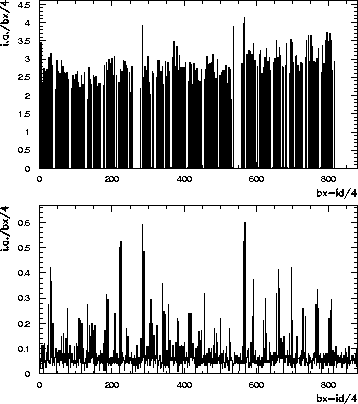


Next: Conclusions
Up: Measurement Examples
Previous: Distribution of Interactions along
The last topic discussed within this issue is the investigations
of individual bunch contributions. All 180 filled HERA proton bunches
contain usually within 10% the same current. For efficient data taking
one aspires similar rate contributions from all bunches
within a narrow time windows of 1 nsec width and equal distances of 96 nsec.
Otherwise one loses efficiency due to high multiplicity events which cannot
be resolved, low multiplicity events with less statistics and uncertainties in
the drift-time measurement lowering the detector resolution.
Fig. 17 shows two measurements taken
with a FADC system which samples the interaction rate signal
with the fourfold bunch-frequency.

Figure 17: FADC measurement of individual bunch contributions.
The first measurement, taken with a wire at the inner beam side, reflects
the bunch filling scheme; all 180 filled bunches contribute very similar
and no interactions are coming out of the gaps between the bunches.
The second example, taken with a wire on the outer beam side,
indicates two problems:
- BX-BX Variations:
-
The individual bunches contribute very different.
Similar shapes of the distribution are measured with wires
from all sides. This indicates that the problem is most likely
correlated with the emittance and/or the lifetime of the individual
bunches. The problem originates most likely during the injection
phase, caused e.g. by slight timing problems in one of the
preaccelerators or the transfer to the next stage -
and the protons preserve their history.
In lot of examples one observes a systematic behavior which
supports this explanation. HERA is working on an improved
timing and a feedback system, which hopefully cures this problem.
- Non Bunch Correlated Interactions:
-
Lot of interactions are not correlated with filled bunches.
This is mainly observed on the outer beam side, no significant
contributions are measured on the inner side.
The amount of this out of proper time contributions varies from
fill to fill. Within one fill these perturbing contributions
saturates at a fixed level, exceeding in worse cases 10 MHz.
The reason for this non bunch correlated interactions is yet not finally
verified. Most-likely it is correlated with the energy loss in the target
and the dispersion in the target area. The mean energy loss of a
820 GeV proton (cp. Tab. 3) per interaction length is
around 400 MeV, a value similar to the maximum momentum tolerance of the
HERA proton RF system. Particles may cross the stable seperatrix in the
longitudinal phase space and start to
travel randomly along the beam tube.
The horizontal dispersion in the target region shifts the orbit of theses
particles by  to the outer side, explaining that the
effect is mainly absorbed on the outer side.
to the outer side, explaining that the
effect is mainly absorbed on the outer side.
A simulation is under development to study this more in detail
and to obtain a quantitative understanding, which is until yet missing.
But the expectations into the simulation are limited, because as soon as
additional nonlinear effects in the beam halo
and interferences between the horizontal and vertical
phase space are getting important one ends up with a rather complex and
challenging beam dynamics study project.
Therefore it's quite important to investigate the problem in some dedicated
machine shifts in 1998; basic studies are the altering of the RF voltage
and the movement either of the beam or of collimators at high dispersion
points.



Next: Conclusions
Up: Measurement Examples
Previous: Distribution of Interactions along
Klaus Ehret
Mon Dec 15 09:36:56 MET 1997

